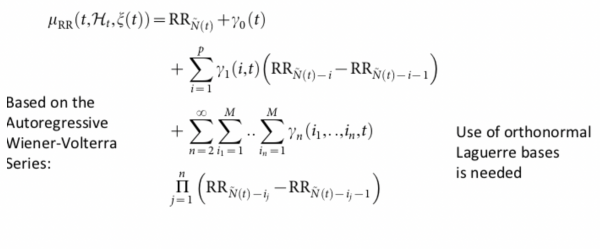This research activity is focused on
- Developing Inhomogeneous Point-Process Models of human heartbeat dynamics
- Extend the framework including nonlinear dynamics
- Extend the framework including multivariate dynamics (e.g., respiration, blood pressure, etc.)
This activity is carried out in strict collaboration with Prof. Riccardo Barbieri (Politecnico di Milano, Milan, Italy, and Mass. General Hospital, Boston, USA), and Prof. Luca Citi (University of Essex, Colchester, UK)
Developing Inhomogeneous Point-Process Models of human heartbeat dynamics
Point process is a powerful statistical tool able to characterize the probabilistic generative mechanism of a sequence of events. As a consequence, it is possible to characterize the pdf of the next ventricular contraction through a parametric formulation of the past heartbeat events. This modeling approach provides efficient continuous estimates of HRV, both RR and HR, at each moment in time without interpolation between the arrival times of two beats. It allows for estimation of instantaneous HR and HRV measures, and measures goodness-of-fit

By using the inhomogeneous point process model of heartbeat dynamics, we model the unevenly sampled RR interval series through probability density functions (pdf) characterizing and predicting the time until the next event occurs as a function of the past history. As major advantages, instantaneous measures can be estimated without applying any interpolation techniques to the RR interval series, and are associated to effective goodness-of-fit measures.

Basic modeling concerns linear hearbeat dynamics:

Basic Matlab code is available here
Extend the framework including nonlinear dynamics
Within this framework, Laguerre expansions of the Wiener–Volterra linear and nonlinear autoregressive terms account for long-term nonlinear information.





Extend the framework including multivariate dynamics (e.g., respiration, blood pressure, etc.)





